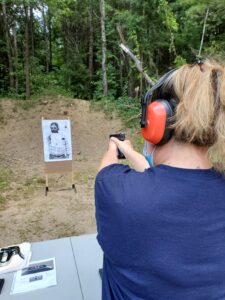- Ammunition: While muzzleloaders are generally exempt from licensing requirements, their ammunition components are generally considered ammunition for the purposes of section 121. However, section 129C(p) exempts the carrying and possession of “so-called black powder rifles and shotguns and ammunition therefore” from the licensing requirements of both residents and non-residents. As such, muzzleloading powder, primers, and bullets for such rifles and shotguns would not require an FID Card or LTC to possess or carry and could even be possessed or carried by an otherwise disqualified or prohibited person. The exemption does not however appear to allow purchasing of such ammunition, or the possession or carrying of such ammunition when used in or with a so-called black powder handgun.
- Not an Assault Weapon: Appendix “A” as discussed in this definition refers to a list of rifles and shotguns that were legally being manufactured on October 1, 1993.
- Assault Weapons are large capacity weapons: All assault weapons under this definition are large capacity rifles or shotguns regardless of the capacity of the magazines currently in the weapon. Assault weapons may be legally owned or transferred by or to a person with an LTC providing the assault weapon was lawfully possessed on September 13, 1994.
- Conviction: A continuance without a finding (CWOF) is not currently considered a conviction in Massachusetts. This “opinion” was reached by the Executive Office of Public Safety, and legal counsels for the State Police and Massachusetts Chiefs of Police Association. Although an admission to sufficient facts is considered a plea of guilty pursuant to c. 278 § 18, that same section clearly states that it is considered a guilty for the purposes of that section (§18). It does not automatically apply to all of Massachusetts General Law. In fact, one legislative attorney has said that if they wanted CWOF’s to be a conviction under c.140, §121 they would have said so in §121 as they did elsewhere (such as in c.90 §8).
- Firearm: This generally refers to handguns throughout Chapter 140 (with the exception of a Firearms Identification Card). However, it also refers to those guns which do not otherwise meet the definition of a rifle or shotgun as defined in section 121.
- Large Capacity Feeding Device: Tubular magazines for .22 LR rifles are excluded by statute from this definition regardless of how many rounds they hold. Also, when counting rounds to determine if a
feeding device is or is not large capacity, only the rounds in the feeding device itself are counted. The round in the chamber is not included when such a determination is made. Possession of a large capacity feeding device by residents requires an LTC, and except for law enforcement, the large capacity feeding device must have been lawfully possessed (or manufactured before) September 13, 1994. - Large Capacity Weapon: Because the terms “capable of accepting” and “readily modifiable to accept” are overly broad, the Executive Office of Public Safety developed additional definitions to help further define a large capacity weapon. These definitions are listed in the introductory paragraphs of the EOPS “Large Capacity Weapons Roster” and are now part of 501 CMR 7.00. The roster lists weapons determined by EOPSS (at the recommendation of the Gun Control Advisory Board) that are always large capacity regardless of the magazine that is with the weapon. This roster and its definition should be referred to in order to gain a better understanding of the definition of Large Capacity Weapon. Weapons not listed on the roster can still be large capacity weapons if they are an assault weapon, or are semi-automatic and are equipped with a large capacity feeding device.
- Violent Crime: These are lifetime disqualification for an FID Card and an LTC. While most violent crimes are felonies, some can be misdemeanors including assault and battery. A list of Massachusetts violent crimes is included in this text.
- Sawed-off Shotguns: These are now illegal in Massachusetts under chapter 269, section 10. They cannot be possessed even by a holder of a federal Class III license. Caution, a legal shotgun with an 18″ barrel can be made into an illegal “sawed-off shotgun” under this definition by installing a pistol grip stock if the overall length then is less than 26″.
- Antique weapons (pre-1900) and replicas of antiques: These weapons are exempt from the licensing requirements (see Comm. v. Jefferson 2012) and all safe storage requirements. Caution – although primitive arms may be exempt from licensing, they are not exempt from the surrender requirements of a restraining order under chapter 209A, or from a requirement to carry rifles and shotguns in an enclosed case while on a public way (unless exempted).
- Assault Weapon Copies: On 07/20/16 the Attorney General issued an enforcement notice regarding copies of assault weapons stating that the prohibition includes copies of the weapons enumerated on the assault weapons list if they pass a similarity test or an interchangeability test. See the enforcement notice in this manual for more information.
- Stun Guns: Now defined as a “firearm” meaning a license to carry firearms is required to possess or carry.

MA and/ or CT, Utah Multi-state Basic Firearms Safety Course & Education. ***Discounted***
By taking this course you will learn: Massachusetts, Connecticut and Utah General Laws pertaining to firearms, safe storage of firearms, safe handling of
